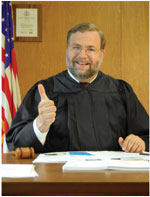Here is a “checklist” of testifying precepts, with which you can “arm yourself” to win in the personal injury courtroom.
Always Be Prepared
Organize your “Go-to-Court” file chronologically. Remove duplicate and non-essential material.
Have a typed curriculum vitae in your “Go To Court” file. Subdivide your post-graduate studies into modules.
Know the following:
The definition of “chiropractic.” Have a copy of your state’s definition of chiropractic in your files.
• “What do you do with patients?”
• “I treat and heal damaged and injured muscles, bones, discs, ligaments and nerves of the body.”
• “I find the spinal bones that are out of place and realign them.”

Review all available medical records prior to court so that the material is fresh in your mind.
Review the ingredients of each vitamin/mineral you give a patient and where these ingredients are found in nature.
Know the contraindications section of The Mercy Conference Guidelines.
Review your anatomy prior to court.
-
Anatomy of the injured area.
-
Cranial nerves.
Review the settings and effects of your physiotherapy.
Back up your testimony with exhibits.
-
Give the exhibits to the patient’s attorney prior to going to court.
The “Do’s” and “Don’ts” of Testifying
-
Do tailor your qualifications to the type of people living in your area.
-
Don’t exaggerate your qualifications.
Don’t be your patient’s advocate (one who pleads the cause of another).
-
Your duty in a courtroom is strictly to present the evidence of an injury.
-
Don’t try to figure out whether your answer will help or hurt your patient’s case.
Do tell the truth. Every truth should be readily admitted.
Don’t talk too fast.
Don’t irritate the jurors by speaking so softly they have trouble hearing you.
Don’t nod your head for a “yes” or “no” answer.
Speak loudly enough so that the court reporter (or recording device) and jury can clearly hear your answer.

Do answer the attorney’s questions in plain English. Avoid “medical jargon,” if possible.
-
Adjust your verbiage to the level of a lay, non-professional audience.
-
Jurors view experts that can’t explain points in lay language as evasive. When you have to use a medical word, translate it into lay terms (i.e., “torn muscle;” disc: “the pad between the spinal bones;” intervertebral foramen: “the nerve holes on each side of the spinal bones;” vertebrae: “spinal bones;” strain: “torn muscle;” sprain: “torn ligaments;” facets: “the glides at the back of the spine;” cephalgia: “headaches.”
Do restrict your opinions to your observations, clinical findings and outcome assessments that are relevant.
-
Your opinions should be based on your scientific documented notes, not circumstantial evidence, philosophy, or unreliable testimony (junk science).
Do stay away from controversial issues.
Don’t overstate the chiropractic philosophy.
Don’t lecture to the jury.
Do stay away from unfamiliar territory. Only answer what you know.
Do correct any verbal mistake.
-
If your answer is not correctly stated, correct it immediately.
Do answer all questions clearly and concisely.
-
If your answer is not clear, clarify it immediately.
-
When you over-explain, you’ll lose the juror’s attention.
Do take time in answering questions.
-
The best answer is in ten words or less.
-
Don’t give a “snap” answer.
-
Don’t elaborate or ramble.
Do pause before answering.
-
Pausing indicates that you are putting thought into your answer.
-
Don’t have an unnaturally long delay to a simple question if you know the answer.
Do avoid making comments that are personal or inappropriate.
Don’t mention insurance or an insurance company during the course of a trial.
Don’t quote another person or publication unless you are in complete agreement with everything the person said or wrote about the subject or chiropractic.
Do speak directly to the jury or to a single juror.
-
Do look at the attorney when he asks you a question.
-
Do look at the jury or at a juror when answering the attorney’s question.
-
Making eye contact with the jury or a juror builds rapport.
Do make sure the jury’s line-of-vision is not obstructed when explaining X-rays or using demonstration models.
-
Don’t hesitate to invite the jury up to an X-ray view box to see details that are not discernible from the jury box.
Do use word pictures.
- “The left shoulder was bruised when it hit the door.”
Do stop instantly when an attorney objects to a question or when the judge interrupts you.
Do turn and ask the judge a question when…
- You need a question clarified.
- An attorney asks privileged information.
- An attorney demands a “yes” or “no” answer and it is not possible to answer the question in such a manner. The judge will rule whether or not a “yes” or “no” answer is mandatory.
Dr. Peter G. Fernandez specializes in building the Personal Injury practice, has written a number of books on Personal Injury and offers pay-for-view videos on the subject. He has been a practice consultant for the last twenty-seven years. Visit Dr. Fernandez online at www.DrFernandez.com (be sure to test drive his two FREE Video Seminar classes). He can be reached via e-mail at [email protected].
